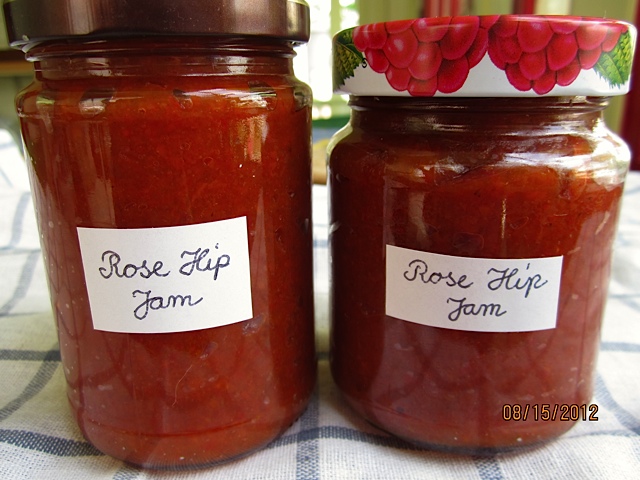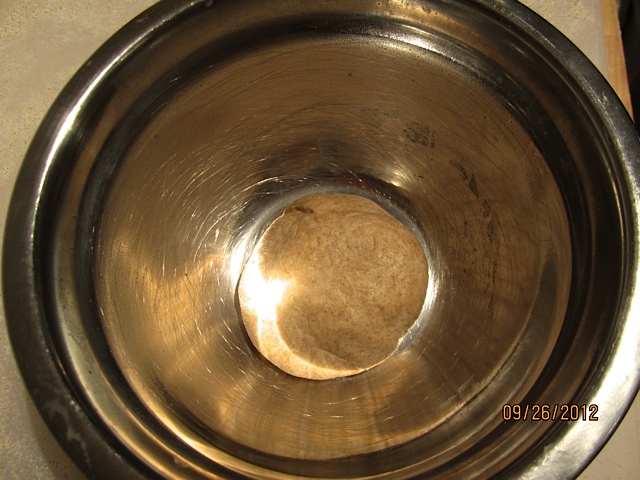
When I made my wonderful rose hip jam a month ago, temperatures were in the eighties, t-shirt weather for weeks, and we even used the air condition in our bedroom - in Maine!
The glasses were sitting on the kitchen counter, waiting to be properly tagged before going into the basement. But my husband, immobilized by a broken foot, needed special attention, and, between baking twice a week for our local natural food store, answering student questions online, and taking care of our undeserving critters, I didn't get to it for quite a while.

After a week or so, I noticed that one of the glasses showed ominous signs of frothy activity. Obviously I didn't fill it quite high enough to establish a vacuum, and, with the prevailing heat as incubator, my rose hip jam had started to ferment.
I was pretty annoyed with myself. Why didn't I pay more attention, and place the compromised glass into the fridge, before it could turn itself into booze?
No help for it, this was a goner, and had to be thrown out..... Or not? Suddenly I remembered my experiences with apple yeast water two years ago. Made from fermenting apples, the yeast water had proved to be a powerful leaven, my bread even grew a horn!
But in the end the apple yeast water died a slow death from starvation in a dark corner of my fridge, all but forgotten, since we preferred the tangier taste of sourdough.
Wouldn't it be worth a try to experiment a bit, and see what would happen if I fed the tipsy jam with flour?

I measured a teaspoon of jam in a little bowl and added equal amounts of water....

....and whole wheat flour to the bowl:

5 g fermented rose hip jam + 25 g water + 25 g whole wheat flour.
Eleven hours later the reddish mixture had become bubbly and spongy, and emitted a wonderful fruity-sour smell.

I fed it two times more, aways with 25 g flour and 25 g water. It ripened faster each time, first after 3, then even only after 2 1/2 hours.
 Fully developed rose hip mother
Fully developed rose hip mother
I was very pleased and contemplated my next move.
I wanted to make a fairly simple levain, with a bit of whole grain, but not too much. I expected a rather mild taste, but I didn't want the blandness of an all-white bread, nor a too hearty loaf that overwhelmed more subtle nuances.
So I adapted a recipe for Pain au Levain, made with apple yeast leaven, from Jan Hedh's "Swedish Breads and Pastries". I had made this bread before, with apple yeast water, it had been nice, but rather mild.
Hedh's book is gorgeous, with wonderful recipes, though not without some pesky errata - my first attempt of an attractive looking Levain with Bran and Vinegar had ended in a dense, compact brick - thanks to one erroneous Zero too many in the bran department.
Even though it was already evening, I didn't want to wait, and started with 16 g of my newborn rose hip mother - mother, chef and levain are the classic French terms for the 3 steps to make a leaven - to make the second stage: the chef.
 Chef after kneading
Chef after kneading
I woke up at midnight, went downstairs, eager to see how my starter was doing, and found a nicely grown chef, wide awake, and hungry for more.
 Fully developed chef
Fully developed chef
After feeding the little guy with more flour and water, I tottered back to bed. The next morning my levain was fully ripened and ready to go!
 Fully developed rose hip levain
Fully developed rose hip levain
PAIN AU LEVAIN (adapted from Jan Hedh: "Swedish Breads and Pastries")
CHEF
21 g mother starter (it doesn't have to be rose hip, an ordinary mature wheat or rye starter will do)
8 g water
21 g bread flour
LEVAIN
50 g chef (all)
50 g water
100 g bread flour
FINAL DOUGH
200 g levain (all)
16 g spelt flour
16 g rye meal
282 g bread flour
219 g water
6 g salt
DAY 1:
1. Mix together all ingredients for chef. Knead for 2 minutes, then let rest for 5 minutes. Resume kneading for 1 more minute. (Dough should be stiff, but not hard, moisten your hands to incorporate more water, if needed.) Cover, and let sit for 4 hours, or until doubled in size.
2. Mix together all ingredients for levain. Knead for 2 minutes, then let rest for 5 minutes. Resume kneading for 1 minute more. (Dough should be stiff, but not hard, moisten your hands to incorporate more water, if needed.) Cover, and let ripen for 5 - 6 hours, or until doubled in size. Knead briefly to degas, and refrigerate overnight.
DAY 2:
3. Remove levain from refrigerator 2 hours before using, to warm up. Cut into smaller pieces and place with flour and water in mixer bowl. Knead for 3 minutes at low speed, then let dough rest for 5 minutes.
4. Add salt and continue kneading for 7 more minutes at medium-low speed. Stretch and fold 1 x, gather dough into a ball, place it in lightly oiled bowl, turn it around to coat with oil, cover, and let rest for 90 minutes.
5. Transfer dough to lightly floured work surface, place hands in the middle and push out the air, stretch and fold 1 x, gather dough into a ball, return it to the bowl, and leave it for another 80 minutes.
6. Push out air again, and let dough relax for 10 more minutes. Shape into a round, place in banneton (seam side up), or on parchment lined baking sheet (seam side down).
7. Sprinkle bread with flour, mist with baking spray, cover, and proof for 60 - 90 minutes (in a warm place), until it has grown 1 3/4 times its original size.
8. Preheat oven to 250º C/482º F, including steam pan. Score bread.
9. Bake bread for 5 minutes, reduce heat to 200º C/400º F, and continue baking for another 15 minutes. Rotate bread 180 degrees, remove steam pan, and bake for 20 minutes more, venting the oven once to let out steam in between.
10. Leave bread in switched-off oven with door slightly ajar for another 10 minutes. Transfer to wire rack and let cool completely.
 Rose Hip Levain crumb
Rose Hip Levain crumb
I changed Jan Hedh's recipe a bit. Instead of long kneading, I added a period of rest (autolyse) while mixing the dough, thereby shaving off some hands-on time.
A total baking time of 60 minutes, as stated in the recipe, was not necessary, my bread was already done after 40 minutes. And leaving it a while longer in the switched-off oven with the door a bit ajar guaranteed a nice crisp crust that didn't soften soon after baking.
Did it taste like rose hips? No. But is was delicious! And not only that: The best of all husbands found it "the crustiest bread you ever made".
One question remains: what was it exactly that gave the bread its marvelous lift? The rose hips? The apples? Or the red wine the jam was made with?
 Bar Harbor Shore Path - where Rugosa roses grow in abundance
Bar Harbor Shore Path - where Rugosa roses grow in abundance







 Fully developed rose hip mother
Fully developed rose hip mother Chef after kneading
Chef after kneading Fully developed chef
Fully developed chef Fully developed rose hip levain
Fully developed rose hip levain Rose Hip Levain crumb
Rose Hip Levain crumb Bar Harbor Shore Path - where Rugosa roses grow in abundance
Bar Harbor Shore Path - where Rugosa roses grow in abundance



